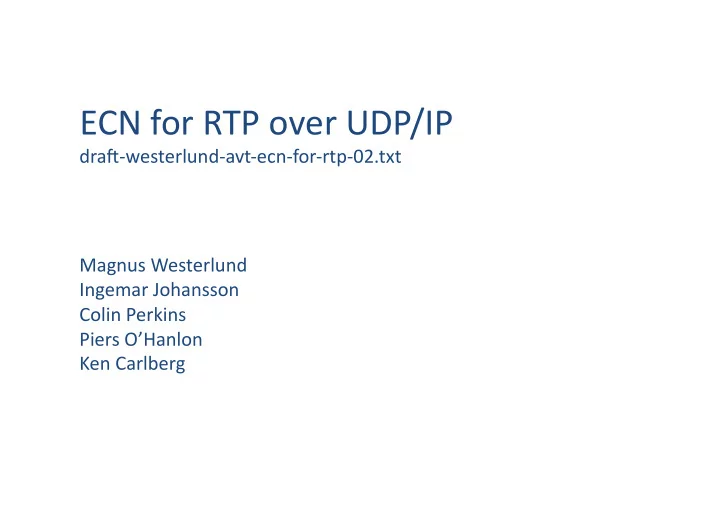

ECN for RTP over UDP/IP dra3‐westerlund‐avt‐ecn‐for‐rtp‐02.txt Magnus Westerlund Ingemar Johansson Colin Perkins Piers O’Hanlon Ken Carlberg
Overview of Proposal • Discusses how ECN can be used with RTP sessions running over UDP/IP – NegoNaNon of ECN capability – IniNaNon of ECN use within an RTP session – Ongoing use of ECN – DetecNng failures and receiver misbehaviour SIP/SDP SIP Proxy SIP Proxy SIP/SDP SIP/SDP RTP data packets + ECT Alice Bob RTCP + ECN feedback 2
Changes since last meeNng • Merged with dra3‐carlberg‐avt‐rtp‐ecn‐02.txt and dra3‐ carlberg‐avt‐rtcp‐xr‐ecn‐01.txt • Added leap‐of‐faith iniNaNon • Made use of ECN nonce opNonal • Updated signalling, RTCP packet formats – Receiver preference for sender ECT: 0, 1, or random • Recommend random, but allow non‐random to avoid disrupNng header compression, especially in controlled environments • Sender can sNll ignore preference to use random – NegoNate capability to read or set ECN bits independently for each session parNcipant • Editorial cleanup 3
IniNaNon of ECN Usage • Three opNons – Probe using RTP data, use RTCP for feedback • Requires 3 RTCP reporNng intervals with ECT marks received and stable receiver populaNon before transiNon to full ECT – Probe using STUN request, feedback on STUN response • One addiNonal RTT to verify ECN‐support once candidate chosen • Only suitable for sessions using ICE for NAT traversal – Leap‐of‐faith: send RTP with ECT, report failure via RTCP • Assumes ECN‐capable path; suitable for controlled network only 4
IniNaNon of ECN Usage Many • STUN/ICE ideal, except not all sessions use ICE • RTP/RTCP works for all sessions, but slow Leap‐of‐faith • Leap of faith fast, potenNally serious failure modes Num.ECT packets (ECN on non‐ECN capable path ‐> total media loss) during iniNaNon Acceptable trade‐off? RTP/RTCP STUN/ICE Few Fast Slow Speed of negoNaNon 5
Ongoing use of ECN with RTP • RTCP reporNng and feedback – Regular RTCP reports to monitor conNnuous operaNon – Use RTP/AVPF with minimal reports for CE events – OpNonal ECN nonce + RLE of lost/marked packets in regular reports • CongesNon response – Sender driven, e.g. TFRC – Receiver driven, e.g. layered coding • DetecNng failure – Misbehaving receivers or middle‐boxes – Path changes and/or mobility ConNnually monitor ECN operaNon and – Group membership changes fallback to non‐ECN mode if necessary 6
Rapid RTCP ECN‐CE feedback 0 1 2 3 0 1 2 3 4 5 6 7 8 9 0 1 2 3 4 5 6 7 8 9 0 1 2 3 4 5 6 7 8 9 0 1 +‐+‐+‐+‐+‐+‐+‐+‐+‐+‐+‐+‐+‐+‐+‐+‐+‐+‐+‐+‐+‐+‐+‐+‐+‐+‐+‐+‐+‐+‐+‐+‐+ | ... Standard RTCP AVPF NACK header ... | +‐+‐+‐+‐+‐+‐+‐+‐+‐+‐+‐+‐+‐+‐+‐+‐+‐+‐+‐+‐+‐+‐+‐+‐+‐+‐+‐+‐+‐+‐+‐+‐+ | Extended Highest Sequence Number | Lost packets counter | +‐+‐+‐+‐+‐+‐+‐+‐+‐+‐+‐+‐+‐+‐+‐+‐+‐+‐+‐+‐+‐+‐+‐+‐+‐+‐+‐+‐+‐+‐+‐+‐+ | CE Counter | not‐ECT Counter | +‐+‐+‐+‐+‐+‐+‐+‐+‐+‐+‐+‐+‐+‐+‐+‐+‐+‐+‐+‐+‐+‐+‐+‐+‐+‐+‐+‐+‐+‐+‐+‐+ | ECT (0) Counter | ECT (1) Counter | +‐+‐+‐+‐+‐+‐+‐+‐+‐+‐+‐+‐+‐+‐+‐+‐+‐+‐+‐+‐+‐+‐+‐+‐+‐+‐+‐+‐+‐+‐+‐+‐+ Sent in RTCP AVPF NACK to indicate CE‐mark received; generally rapid feedback Extended highest sequence number start value unpredictable Counters are cumulaNve and start at zero ‐> provides some robustness to loss of feedback ‐> duplicates included in the count 7
Regular RTCP‐based Feedback 0 1 2 3 0 1 2 3 4 5 6 7 8 9 0 1 2 3 4 5 6 7 8 9 0 1 2 3 4 5 6 7 8 9 0 1 +‐+‐+‐+‐+‐+‐+‐+‐+‐+‐+‐+‐+‐+‐+‐+‐+‐+‐+‐+‐+‐+‐+‐+‐+‐+‐+‐+‐+‐+‐+‐+‐+ | ... Regular RTCP XR header ... | +‐+‐+‐+‐+‐+‐+‐+‐+‐+‐+‐+‐+‐+‐+‐+‐+‐+‐+‐+‐+‐+‐+‐+‐+‐+‐+‐+‐+‐+‐+‐+‐+ | SSRC of Media Sender | +‐+‐+‐+‐+‐+‐+‐+‐+‐+‐+‐+‐+‐+‐+‐+‐+‐+‐+‐+‐+‐+‐+‐+‐+‐+‐+‐+‐+‐+‐+‐+‐+ | CE Counter | not‐ECT Counter | +‐+‐+‐+‐+‐+‐+‐+‐+‐+‐+‐+‐+‐+‐+‐+‐+‐+‐+‐+‐+‐+‐+‐+‐+‐+‐+‐+‐+‐+‐+‐+‐+ | ECT (0) Counter | ECT (1) Counter | +‐+‐+‐+‐+‐+‐+‐+‐+‐+‐+‐+‐+‐+‐+‐+‐+‐+‐+‐+‐+‐+‐+‐+‐+‐+‐+‐+‐+‐+‐+‐+‐+ Sent in regularly scheduled compound RTCP packet, with RTCP SR/RR ‐>O(seconds) reporNng interval Same staNsNcs as rapid feedback report, when combined with SR/RR Provides robustness against lost reports 8
Handling duplicaNon of RTP packets • The counters have an issue with packet duplicaNon – Each received packet will be counted by receiver => receiver will have counters where sum over them is larger than number sent – Duplicate packets may arrive with different markings, for example as ECN‐CE and as ECT – This creates uncertainty in verificaNon process • If number of duplicates are larger than re‐marked packets it may not be detected. • Sender needs more advanced logic to determine issues – Tracking duplicaNon requires substanNal receiver state • Not done in regular RTCP Receiver reports
Transport of ECN nonce in RTCP 0 1 2 3 0 1 2 3 4 5 6 7 8 9 0 1 2 3 4 5 6 7 8 9 0 1 2 3 4 5 6 7 8 9 0 1 +‐+‐+‐+‐+‐+‐+‐+‐+‐+‐+‐+‐+‐+‐+‐+‐+‐+‐+‐+‐+‐+‐+‐+‐+‐+‐+‐+‐+‐+‐+‐+‐+ | ... Regular RTCP XR header ... | +‐+‐+‐+‐+‐+‐+‐+‐+‐+‐+‐+‐+‐+‐+‐+‐+‐+‐+‐+‐+‐+‐+‐+‐+‐+‐+‐+‐+‐+‐+‐+‐+ | BT |R|R|R|R|INV|RNV| Block Length | +‐+‐+‐+‐+‐+‐+‐+‐+‐+‐+‐+‐+‐+‐+‐+‐+‐+‐+‐+‐+‐+‐+‐+‐+‐+‐+‐+‐+‐+‐+‐+‐+ | SSRC of Media Sender | +‐+‐+‐+‐+‐+‐+‐+‐+‐+‐+‐+‐+‐+‐+‐+‐+‐+‐+‐+‐+‐+‐+‐+‐+‐+‐+‐+‐+‐+‐+‐+‐+ | Begin_seq | End_seq | +‐+‐+‐+‐+‐+‐+‐+‐+‐+‐+‐+‐+‐+‐+‐+‐+‐+‐+‐+‐+‐+‐+‐+‐+‐+‐+‐+‐+‐+‐+‐+‐+ | chunk 1 | chunk 2 | +‐+‐+‐+‐+‐+‐+‐+‐+‐+‐+‐+‐+‐+‐+‐+‐+‐+‐+‐+‐+‐+‐+‐+‐+‐+‐+‐+‐+‐+‐+‐+‐+ : ... : +‐+‐+‐+‐+‐+‐+‐+‐+‐+‐+‐+‐+‐+‐+‐+‐+‐+‐+‐+‐+‐+‐+‐+‐+‐+‐+‐+‐+‐+‐+‐+‐+ | chunk n‐1 | chunk n | +‐+‐+‐+‐+‐+‐+‐+‐+‐+‐+‐+‐+‐+‐+‐+‐+‐+‐+‐+‐+‐+‐+‐+‐+‐+‐+‐+‐+‐+‐+‐+‐+ 2‐bit Nonce XOR sum; chunks run‐length encoded list of lost/CE‐marked packets Use of ECN nonce is OPTIONAL, to detect cheaNng receivers – regular reports allow detecNon of non‐ECN‐capable middle‐boxes 10
Other Issues • Consider iniNaNon opNmizaNons to allow for mulN‐ SSRC sender nodes to have rapid usage of ECN • Feedback suppression for ECN‐CE reports, both for groups, and in case an addiNonal CE mark arrives within an RTT at the receiver 11
AcNons and Future DirecNons • Hope to charter as an AVT work item, with parallel review and last call in TSVWG – This dra3 will conNnue to focus on how to signal and convey ECN for use with RTP sessions over UDP/IP – Detailed congesNon response for real‐Nme traffic will not be specified in this dra3 • System must respond to ECN‐CE marks in the same way it responds to packet loss (there are a range of soluNons) 12
Recommend
More recommend